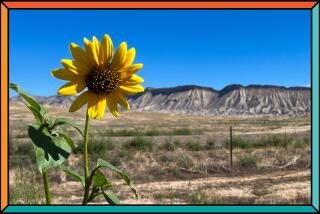Call to Colors
If you need extra motivation to pull on your hiking shoes and head for the hills, here it is: Spring wildflowers are blooming.
So far, the headliner in the annual show of colors is coreopsis, the daisy-like shrub that now dots the coastal hillsides in a blaze of yellow, especially visible from Pacific Coast Highway.
Inland, the curtain is rising a little more slowly, but by late March the wildflower season, which extends through April, will peak. Youâll see everything from the orange-red Indian paintbrush to the vivid purple nightshade to that dazzling showstopper the California poppy.
But suppose you donât know a poppy from a Popsicle. Donât despair. You can sign up for a slew of wildflower hikes this spring with flower experts who can identify anything in bloom and just about anything that isnât.
One of the most celebrated local experts, Milt McAuley, is leading four wildflower hikes in the Santa Monica Mountains through a program offered later this spring by the Learning Tree University in Chatsworth. On March 30, you can join him for a free wildflower hike at Chatsworth Park South.
If you canât hike with McAuley, you can do the next best thing: Pick up his book, âWildflowers of the Santa Monica Mountainsâ (Canyon Publishing Co., $19.95). Written 10 years ago and revised last year, it has 496 color photos of what blooms here.
At 77, McAuley, who lives in Canoga Park, is a walking encyclopedia when it comes to the Santa Monica Mountains. Vigorous and with just a trace of a paunch, he hits the trail often, averaging 20 miles of walking a week.
With his bushy eyebrows and mustache, heâs been likened to Walter Cronkite. And when he speaks about the mountains in his slow and deliberate manner, the resemblance is even more striking.
On a blustery morning late last month, he led the way up La Jolla Canyon in Point Mugu State Park to scout out early wildflower blooms. The trail just off Pacific Coast Highway is one of his favorite haunts, and that morning he wasnât disappointed.
Coreopsis was everywhere. This native shrub grows primarily along the coast, between Point Dume just above Malibu and Point Conception in Santa Barbara County, and on the Channel Islands. Three years ago, fire devastated much of the coreopsis in the state park.
âI like the way these are coming back,â McAuley said. âItâs a great season for coreopsis.â Although itâs past its peak, some coreopsis should be in bloom a few more weeks.
It may be a good season for other bloomers too. The wildflowers here are still feeling some beneficial effects of the fire, which burned away chaparral and gave them space to proliferate. And, of course, the chaparral is on the rebound.
Tapia Park, south of Agoura Hills, may hold great promise for wildflowers this season because of the fire there last fall. But you wonât be disappointed elsewhere.
âItâs a good year,â McAuley said. The early heavy rains followed by a spell of warm weather helped move things along, so the wildflowers are blooming a bit earlier than usual this year.
As he strolled up the La Jolla Canyon Trail, he pointed out yellow deer weed, morning glories, blue dicks, purple nightshade, to name a few. He spotted a lush spread of what looked like coreopsis to the untrained eye. Canyon sunflower, he said, pointing to the leaf pattern.
A waterfall spilled over boulders next to the trail and McAuley hopped nimbly over. He talked of the Chumash, the canyonâs first residents, and how decades ago rock was stripped from here to build the Pacific Coast Highway.
Around the next bend we would find marine fossils embedded in the rock, he said. Sure enough, there they were, plain as day, but probably unnoticed by the thousands of hikers who traipse through here.
At one point, the trail was almost canopied by pale blue California lilacs--an awesome sight.
âItâs a rather stunning plant,â he said with characteristic understatement.
But it was shooting stars and the elusive chocolate lily that were on his mind that day and he was determined to find them. After two miles or so, the trail opened onto a grassy meadow and he spotted a scattering of white and lavender shooting stars.
âWhere you find shooting stars you find chocolate lilies,â he said, scanning the meadow. Sure enough, moments later he spotted a single bronze-colored chocolate lily, and then a few others here and there. âA lot of people would go by here without noticing,â he said triumphantly.
In fact, a lot of people, accustomed to cultivated gardens, anticipate they will be bowled over by vast fields of colorful wildflowers when they hit the trail in the spring. But itâs a more subtle experience.
(If youâre headed for the California Poppy Reserve in Lancaster, donât get your hopes up. The poppies got little rain, bloomed early and the displays are disappointing, the reserve reports.)
When McAuley leads one of his wildflower walks, he gives them his standard line: âDonât expect too much--and be patient.â
Flowers reach their peak bloom at different times, and if youâve missed the shooting stars and chocolate lilies, other varieties have come along.
It took McAuley three years to compile his wildflower book. For the most part, heâs self-taught, except, he conceded, âI took every botany course I could get my hands on at Pierce College.â
He was headed for a career as a forest ranger when World War II intervened. Instead, he went into the Air Force, became a pilot and spent 21 years in the military before retiring as a major in 1961. He took a job in the aerospace industry, moved to the San Fernando Valley and began to roam the Santa Monica Mountains.
He decided to write a book about hiking in the mountains 18 years ago, but a publisher who had encouraged him ended up rejecting his manuscript. Undeterred, McAuley published the book âHiking Trails of the Santa Monica Mountainsâ himself, forming his home-based Canyon Publishing Co.
âI borrowed money from my life insurance,â he said. He also vowed he would sell 50 books a week or go without supper on Saturday night. âIn 18 years, Iâve met or exceeded that.â
He has sold about 50,000 copies of the book. Six other books about the local mountains followed, including one on wildflower hiking trails. Somehow he finds the time to hike, as well as work regularly with volunteer trail maintenance crews.
âEvery year the hills get a little steeper,â he said with a sigh.
(BEGIN TEXT OF INFOBOX / INFOGRAPHIC)
Take a Hike
LOCAL FAVORITES
We asked wildflower expert Milt McAuley for advice on where to go to see some glorious blooms. Here are some of his favorite hiking spots and a few locations others have recommended:
* La Jolla Valley in Point Mugu State Park, just off Pacific Coast Highway. Look for the Ray Miller Trail Head at the turnoff for La Jolla Canyon. Try the La Jolla Valley Loop Trail.
* Circle X Ranch, Santa Monica Mountains National Recreation Area. Take PCH to Yerba Buena Road, just above the Los Angeles County line. Circle X Ranch is five miles up Yerba Buena. Try the Mishe Mokwa Trail.
* Nicholas Flat, Leo Carrillo State Park, off PCH, just below the Los Angeles County line. Take Decker Road inland 2.5 miles and bear left on Decker School Road for about 1.5 miles to the end.
* Rancho Sierra Vista/Satwiwa Site, near Newbury Park in the Santa Monica Mountains National Recreation Area. Take the Wendy Drive exit off the Ventura Freeway and follow it to the end. Turn right on Potrero Road, left at the stop sign and left at Pinehill Road. Try Old Boney Trail.
* Rocky Oaks, south of Westlake Village in the Santa Monica Mountains National Recreation Area. From the Ventura Freeway, go south on Kanan Road to Mulholland Highway. A fenced area near the pond protects the endangered Pentacheata lyonii, a tiny yellow sunflower-like plant. Try the trail along the stream west of the picnic tables.
* Wildwood Park in Thousand Oaks. From the Ventura Freeway, take Lynn Road north and Avenida de Los Arboles west to Big Sky Drive. Try the Mesa, Stagecoach Bluff or Moonridge trails.
* Rocky Peak Park, east edge of Simi Valley. Try the Hummingbird Trail. Located at Kuehner Drive exit, north of the 118 Freeway.
WILDFLOWER CALENDAR
Here are some organized wildflower hikes and events:
* Saturday, La Jolla Valley parking lot, Point Mugu State Park, off Pacific Coast Highway; 9 a.m. to 3 p.m. Interpretive wildflower hike to the waterfall, wildflower bingo, and kidsâ activities. For information, California Department of Parks and Recreation: (818) 880-0350.
* March 30, Sierra Club Easter hike led by Milt McAuley, Chatsworth Park South; 9 a.m. to 1 p.m. For information: (818) 347-6433.
* April 5, Santa Barbara Botanic Gardenâs annual wildflower festival, 10 a.m. to 4 p.m.; $3 for adults, $2 seniors and students, $1 children, under 5 free. For information: 682-4726.
* Beginning May 4, a series of four Sunday wildflower outings in the Santa Monica Mountains led by Milt McAuley through Chatsworthâs Learning Tree University; $49. To register, call (818) 882-5599.
FOR MORE INFO
* National Park Service, (818) 597-9192.
* Los Padres National Forest, Ojai ranger district, (805) 646-4348.
* California Department of Parks and Recreation, (818) 880-0350.
* California Poppy Reserve in Lancaster, (805) 724-1180.
* Theodore Payne Foundation wildflower hotline, (818) 768-3533.
More to Read
Sign up for The Wild
Weâll help you find the best places to hike, bike and run, as well as the perfect silent spots for meditation and yoga.
You may occasionally receive promotional content from the Los Angeles Times.






